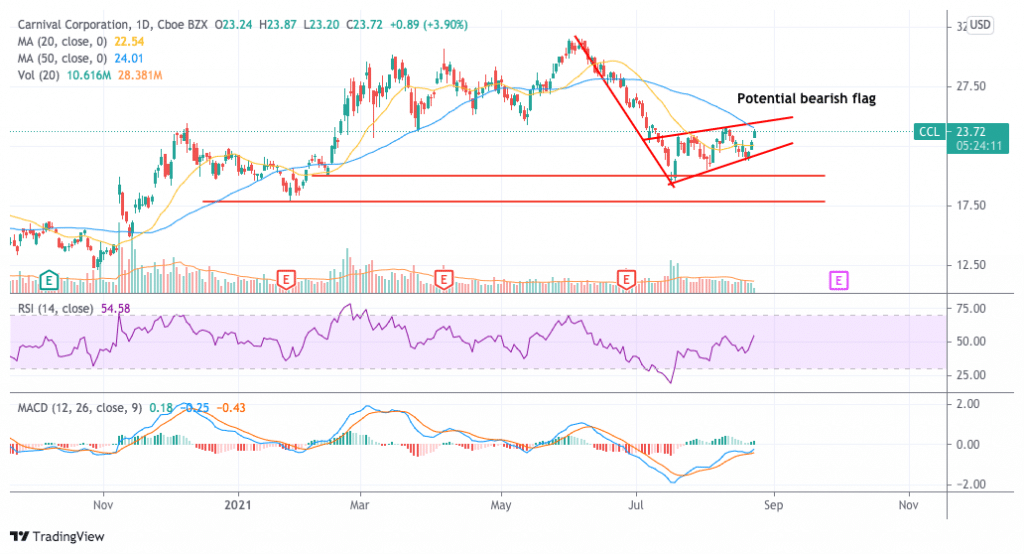Carnival Stock Up 9% in August – Time to Buy CCL Stock?
Please note that we are not authorised to provide any investment advice. The content on this page is for information purposes only.
The price of Carnival stock is up 9% so far in August while shares have seen gains in the past three sessions as the travel and leisure segment of the market has appeared to be bottomed after the strong hit it took between June and July.
This latest recovery has pushed Carnival stock to positive territory on a yearly basis, with the stock managing to deliver 9% annual gains despite the sharp drop it experienced in the past two months.
Could this rebound be the beginning of a full-blown trend reversal or is Carnival stock poised to resume its downtrend on the back of a prolonged virus crisis?
In the following article, I’ll analyze the latest price action along with other relevant factors to possibly answer that question.
67% of all retail investor accounts lose money when trading CFDs with this provider.
Carnival Stock – Technical Analysis

The latest rebound in the price of Carnival stock seems to have taken place at a moment when all technical momentum indicators were flashing their worst readings since the March 2020 pandemic crash – emphasizing the impact that concerns about the Delta variant had on the company’s valuation.
Moreover, the price seems to have bounced after a failed break of a horizontal support found at the $20 level while the price action has been posting a series of higher highs and higher lows since then.
If we combine the June-July downtrend with this latest setup, a bearish continuation flag pattern seems to have emerged to warn investors about a potentially short-lived bounce – also known among Wall Streeters as a dead cat bounce.
What this pattern usually signals is that the former downtrend has found a temporary floor, usually due to overheated technical readings, and buyers have stepped up to buy the dip with the expectation that the price may start to recover from that point forward.
However, bearish flags tend to be a mere pause in what could be a prolonged downtrend that could emerge when a business’s fundamentals are rapidly deteriorating.
For now, this pattern is unconfirmed unless the price breaks below the lower trend line shown in the chart. However, if such a break occurs, investors should prepare for a continuation of the June-July downtrend and possibly for a retest of the $20 threshold.
Carnival Stock – Fundamental Analysis
Carnival has been unable to generate sales for four consecutive quarters now as a result of the virus situation although the company has already restarted its trips from and to a few selected locations this month.
For this upcoming third quarter of the year, the company is expected to report sales of around $740 million while revenues are expected to jump to $1.7 billion by the end of the fourth quarter as the company expects to operate at 75% capacity by then.
For the entire year, sales are expected to land at $2.8 billion while analysts are forecasting a recovery in Carnival sales to pre-pandemic levels by the end of 2023.
Interestingly, the company seems to be fairly optimistic about its outlook as indicated by a series of stock repurchases the management has made in the past couple of months. These repurchases may have helped in creating a floor for the stock during the latest sell-off as the company bought almost 500,000 shares on 20 and 21 July – right when the stock bottomed.
Since then, Carnival’s management has been progressively buying its shares and this may indicate that insiders believe that the stock is trading at an attractive price.
Moving forward, any developments that affect the business’s ability to increase its used capacity will likely have a strong effect on the price of Carnival stock. For now, the company remains on track to progressively resume its operations and this could support further upward movements in the stock price on the back of these higher forecasted sales.
At its current market capitalization of $24.43 billion, Carnival is trading at only 1.2 times its pre-pandemic full-year sales while, at the current price of $23.7 per share, the stock is trading at 8.5 times its pre-pandemic adjusted earnings per share.
Moving forward, even though the company’s higher long-term debt could continue to depress its bottom-line profitability for a while, its current valuation multiples remain fairly depressed and this could present an opportunity for long-term holders to buy the company with the expectations that multiples should progressively expand once the uncertainty resulting from the virus crisis fades.
That said, investors should be cautious about the bearish bias of the current technical setup while the company’s decision to buy back its shares at a point when the dust has not yet settled for cruise line operators may be a bit reckless – particularly upon considering the sizable amount of debt that the company now holds.





